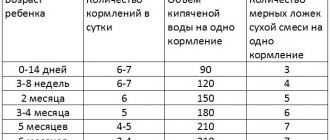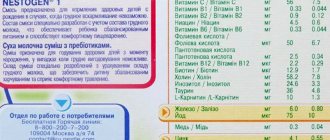How to choose the right product
A child who is completely bottle-fed or mixed-fed needs high-quality nutrition, and in order to meet the needs of the child’s body, mothers should listen to the sensible advice of those who have had to deal with a similar problem:
You cannot rely on your intuition and select the formula yourself, talk first with a doctor - he will help in choosing, knowing the characteristics of the child. When purchasing products, you should be interested in the expiration date. Even if, judging by the numbers, the food can be used for several more weeks, it is better to choose another, more fresh one.
You should always pay attention to the composition of baby food. What should be included in it and what should be avoided is written at the beginning of the article
When it comes to infant formula, it is necessary to choose the best products from well-known manufacturers that have proven themselves to be positive. It is advisable to constantly feed the baby the same food, so if the child likes the mixture and does not cause negative effects, you can buy several packages of the product at once.
Regarding child age suitability:
- packs marked with zero are usually chosen for newborns and children born prematurely;
- one symbolically indicates age from 0 to 6 months;
- from six months to a year it is necessary to purchase products labeled “2”;
- Older children need mixtures with the number “3” as a marker.
If parents can understand that formula is not suitable for their child, they can prevent problems with the baby’s health and feed him only high-quality food in the future.
What mistakes should you avoid?
Parents need to understand that switching a child to adapted products is always a stressful state for a baby, and negative manifestations can affect a few weeks after the start of feeding.
To avoid violations, it is important to follow some rules:
- Adhere to a certain nutritional plan - for artificial children, a schedule is necessary, and feeding on demand often causes disruptions in the functioning of the digestive tract.
- There is no need to immediately change one mixture to another at the slightest change in the baby’s well-being - it takes a single day for the body to adapt, and frequent changes of products can bring new troubles.
- It is a serious mistake to switch from artificial nutrition to cow's milk, since not all the substances present in it are beneficial for infants.
- You cannot switch a newborn to medicinal products on your own - this can only be done by a doctor, in accordance with the available indications.
- The preparation of mixtures from dry powder should take into account the concentration recommendations. Carefully follow all the instructions on the packaging.
- Doctors do not advise uncontrollably giving children formulas based on fermented milk products, or constantly subjecting food to heat treatment that is not always appropriate.
Knowing all the listed nuances and how to understand that the formula is not suitable for the child, you can feed the baby with an adapted diet for a high-quality and long period of time, avoiding negative reactions and poor health of the baby.
Possible side effects when changing diet
Often, with a sudden change in nutrition, the following side effects occur in a newborn:
- dysbacteriosis;
- bloating;
- diarrhea, constipation;
- loss of appetite;
- dermatitis;
- sleep disorders.
If you do not pay attention to these signs in time, then in the future the child may have serious problems with the gastrointestinal tract.
Another way out of the situation would be to change your diet to a new one. In some cases, introducing special fermented milk products into the baby's diet can also help. However, they should be introduced into the diet only after prior consultation with a pediatrician.
If you are allergic to the dry product, it can be diluted with goat's milk. Although it is inferior in its nutritional properties to cow's milk, it is much less likely to cause stomach upset and other allergic reactions.
So, before switching your newborn to another formula, you should first consult with your pediatrician. An experienced specialist will select the most suitable nutrition in accordance with the characteristics of the baby’s body.
Detection of mixture intolerance
Before rushing to replace the mixture, you need to make sure that it really is not suitable. Formula intolerance usually involves the body's inability to break down cow's protein.
If your baby develops any skin reactions or digestive problems, it is important to make sure that the mother prepares the portion correctly:
- The ratio of water and dry matter must strictly correspond to the proportions indicated on the packaging. Many mothers, thinking that by adding more scoops to the bottle, they will make the formula healthier and more nutritious, are greatly mistaken. Violation of proportions during cooking almost always causes dermatitis and problems in the gastrointestinal tract. Excess protein and fat in an improperly prepared portion puts excess stress on the liver and kidneys.
- The amount of mixture drunk should not exceed the volume stated on the package for each age group. Overeating causes increased gas formation in the intestines and abdominal pain.
- Preparing the mixture for future use, especially storing it in a water bath at night, leads to intestinal infections. You can only feed your child a freshly prepared portion, because it is a breeding ground for the proliferation of pathogenic bacteria. For the same reason, it is necessary to thoroughly wash the bottle, nipple and all its folds after each use, using a stiff brush or brush.
If each portion is always prepared by the mother according to the rules, and the child does not overeat, but at the same time there are obvious problems with digestion, it is worth thinking about how to understand that this particular mixture is not suitable for the child.
Preparing the mixture
What are the symptoms?
Unpleasant symptoms associated with a reaction to milk protein can occur for two reasons:
- allergy to cow's milk protein;
- Milk protein intolerance.
If the symptoms are associated specifically with an allergic reaction, then the child will have to give up dairy products for life. Intolerance most often goes away with age. By the age of three, most of the negative reactions that arise from drinking milk disappear, due to the maturation of the intestines and an increase in the quantity and quality of bile enzymes.
Protein intolerance causes the following symptoms:
- severe abdominal pain;
- diarrhea;
- vomit.
If the baby has an allergy, symptoms characteristic of intolerance may appear; the main distinguishing criterion is skin reactions. It is dermatitis that becomes the reason to visit an allergist.
When do the signs appear?
An allergic reaction appears within 15 minutes after taking the mixture and can linger for a long time. With age-related milk protein intolerance, the first symptoms will appear immediately after the first drops of what is eaten enter the duodenum, since it is the duodenum that first reacts with the inability of the existing enzymes to break down the product.
It will take 3-4 weeks to diagnose an allergic reaction. To achieve a reliable result you must:
- exclude milk protein from food for a long time;
- observe the disappearance of dermatitis and disturbances in the gastrointestinal tract within 3-4 weeks;
- as soon as the symptoms have completely disappeared, give a single portion containing the suspected allergen - milk;
- When previously disappeared health problems reappear, a diagnosis of “cow protein allergy” is made.
Important! Children who are not only bottle-fed, but also breast-fed, may show signs of allergies. If a nursing mother eats cottage cheese, cheese or any other dairy product, the protein will enter her milk, and then into the newborn’s gastrointestinal tract
What to do if the food is not suitable?
If you realize that the baby has health problems due to the artificial formula, or the baby is not gaining well, an experienced pediatrician will help you choose the right food. Dealing with this issue yourself is undesirable and even dangerous for the baby. However, it’s a good idea for every mother to know what mixtures are and how they differ.
So, you are in the store. What do you pay attention to when choosing the right product?
Age group
. Food marked “0” or “Pre” on the packaging is suitable for premature and low birth weight babies; with the number “1” – from birth to 6 months; “2” – from 6 months to 1 year; “3” and “4” – older than a year. This is important to consider whenever you buy food, because the composition of the mixtures changes depending on the age-related needs of the child’s body. By purchasing a package with more than the required amount, you risk overloading the baby’s gastrointestinal tract, kidneys and liver, and by leaving older children on a light diet, you are depriving them of the required amount of vital microelements. Formula for low birth weight babies is not recommended for use after the child’s body weight reaches 3.5 kg or other criteria are met according to the instructions.
Purpose
. Depending on the state of health, the baby will be suitable for classic or specialized (therapeutic) nutrition; the latter can be both neutral and fermented milk, low-calorie and high-calorie.
Release form
. Artificial nutrition for infants is produced in powder and liquid form. The first form is convenient because it has a longer shelf life after opening the package, but cannot be stored in a diluted form. Liquid nutrition does not need to be diluted; it is ready to use and, once opened, can be refrigerated for 12 to 24 hours.
Mixture base
. Artificial nutrition is mainly produced on the basis of cow, goat or soy milk.
Milk protein processing level
. Formulas are also divided into adapted (based on demineralized whey of cow or goat milk - as close as possible to breast milk), partially adapted, subsequent (made from whole cow's milk - does not contain whey) and non-adapted (based on casein - a little harder to digest and are recommended after 6 months).
Taste
. Most baby food has a neutral or sweet taste. However, some types of artificial nutrition for infants (especially medicinal ones) may taste bitter due to the individual characteristics of individual components.
If the child does not have serious health problems, it will not be difficult for him to find food. Otherwise, to change the diet, it is necessary to know the cause of the newborn’s illness. Depending on this, specialized or therapeutic nutrition is suitable:
• For premature and low birth weight babies, as well as for children in the recovery period after illness and small children - this is a high-energy food, rich in protein and vitamins.
• Fermented milk, for problems with the gastrointestinal tract (constipation, bloating, colic, dysbacteriosis) - contains lactic acid and bifidobacteria.
• Hypoallergenic, using hydrolyzed (partially broken down) protein.
• Antireflux, for vomiting, frequent regurgitation - contains thickeners.
• With a high iron content, for anemia - for children over 4 months.
• Lactose-free and soy: with complete intolerance to cow's milk proteins, casein, lactose.
Food allergies
After eating, the baby's skin became covered with a rash, cough and runny nose. The rash can be observed on the face, head, and other parts of the body. In some severe cases, hives may occur. This is how an allergic reaction to the mixture manifests itself. Therefore, when swaddling a baby, you should carefully examine his skin. In any case, if allergic reactions occur, this is a sign that the newborn’s body did not like the proposed food novelty. Pediatricians advise observing the baby's reaction to a new type of formula for 72 hours. If the body adapts to the innovation, then the rash and itching of the skin go away. If the symptoms remain, you need to study the composition of the mixture and select the next one so that these components do not appear in the new one. Therefore, you should definitely contact your pediatrician for advice.
Allergy to formula milk
An allergic reaction to infant formula is the first sign that it is not suitable for him. Allergies can manifest as constipation, colic, diarrhea, regurgitation and rashes and are quite common. Typically, this reaction of the body occurs in the second month of life, but can appear at any age. What to do in such cases and how to fight so as not to provoke more severe forms of it?
First of all, you should try to dilute a smaller amount of dry powder in the same volume of water as before, that is, make a less concentrated mixture. This will reduce the load on the gastrointestinal tract and eliminate fermentation in the intestines. If this option does not help, you should think about changing the product or introducing additional nutrition into the diet, in the form of medicinal mixtures.
If the allergy is caused by dysbiosis, you can try adding a fermented milk mixture to your baby’s regular daily menu, which helps restore the intestinal microflora. Typically, such mixtures contain probiotics, which increase the number of beneficial microorganisms in the child’s intestines, normalizing his function and stool.
Normally, in a healthy baby, the number of regurgitations after feeding is one to two; if an allergy occurs, their number increases several times and often turns into prolonged hiccups. In this case, it would be appropriate to add an anti-reflux mixture to the baby’s diet and drink it in a course. It has a thicker consistency due to the locust bean gum, casein or starch present in the composition. The effect of such a mixture is as follows: when it enters the stomach, it swells and forms a dense, thick lump, which the child is not able to regurgitate.
An excellent alternative to a mixture with cow protein can be a product based on goat milk. Such mixtures are excellent for infants, contain the required amount of animal proteins and are superior to regular ones in nutritional value.
Any prescription, be it replacing a newborn’s diet or introducing medicinal mixtures into the diet, must come from a pediatrician. Self-indulgence in this matter should be completely excluded.
Read further:
The use of fermented milk formula for infants
Frequency of changing baby formula
How to properly introduce complementary foods to your baby
Signs that your diet is not right
To understand this, pay attention to the following symptoms in a baby:
• allergic reaction in the form of a rash;
• poor sleep, increased nervousness or lethargy;
• crying and refusal to eat;
• frequent regurgitation;
• low weight gain;
• constipation, diarrhea, severe flatulence.
The manifestation of at least one symptom is a reason to think and figure out: is the cause of the problem due to inappropriate nutrition or something else? So, it is necessary to distinguish between an allergic reaction to some component of the mixture and to cow protein (lactoglobulin). Signs that a child does not accept cow protein well are:
• rash on the face, chest and abdomen, in the groin area;
• wet spots and crusts;
• problems with the gastrointestinal tract, traces of blood in the stool;
• prolonged runny nose and cough.
In most cases, it is enough to transfer the baby to a suitable formula based on goat's milk, which is considered more easily digestible, or to soy formula. However, there is no guarantee that the baby’s body will not react negatively to casein (albeit in a “safer” form) and lactalbumin. A reaction can also occur to soy protein. Therefore, if an allergy or protein intolerance is suspected, laboratory tests must be performed. Symptoms similar to cow protein allergy are also observed with lactose intolerance associated with lactase deficiency.
Poor sleep and flatulence can be associated not only with taking the wrong formula, but also with an incorrect position during feeding or an incorrectly selected bottle, which causes the baby to swallow a large amount of air. It is easy to confuse colic with gas, which does not depend on nutrition and can arise literally out of nowhere. In this case, the child’s cry does not stop for 1-2 hours and often requires taking painkillers.
A baby may also suffer from stomach pain, frequent regurgitation, and vomiting if there are problems with the gastrointestinal tract associated with organ pathology, the physiological development of the newborn, or overeating. Other causes of restless sleep may be, depending on the age of the child, hunger, thirst, inappropriate temperature conditions, dry air in the room, night terrors, weather dependence and much more.
If constipation or diarrhea is a rare, occasional occurrence, then most likely it is not the mixture. Sometimes poor appetite is associated with well-being, and a complete refusal to eat is due to the fact that the baby simply does not like the taste of food, but such pickiness is more typical for children over 6 months old. But poor weight gain is always a reason to worry about the child’s health and review his diet.
How to transfer a child from breastfeeding to formula?
In order for the baby’s body to easily adapt to a new type of nutrition, it is necessary to make a gradual transition. The child must have time to try the new taste, and his digestive system must get used to the mixture.
Currently, a large number of different schemes for switching to mixtures have been developed. However, they are all united by a single principle - a gradual increase in the portion of the mixture.
Conventionally, the entire transition process can be divided into the following stages:
- Consultation with a pediatrician. Before deciding to stop breastfeeding, it is imperative to consult with a specialist.
- Choosing a suitable mixture, as well as convenient dishes for feeding (this point will be discussed in more detail below in the text).
- Gradual introduction of the mixture, starting with small portions.
How to start the transition?
Blend selection
Having made a firm decision to switch to artificial feeding, you need to think about the right choice of formula. This process should be approached responsibly, and be sure to take into account the baby’s health status, level of physical development, as well as his age.
Undoubtedly, no substitute can exactly replicate the unique composition of breast milk, but with the right choice of formula, the baby will receive all the nutrients it needs for normal growth and development.
When choosing a mixture, you should adhere to the following recommendations:
- For newborn babies, you need to buy only adapted formulas (for example, “Frisolak”, “Hipp”, “NAN”, “Humana”, etc.) - they are well digested and also perfectly absorbed by the baby’s body.
- When buying a formula, you should definitely take into account the age of the baby - as a rule, it is written on the box what age this or that composition is intended for.
- If the baby has digestive problems or other diseases, it is necessary to choose a medicinal or specialized mixture.
- You should not blindly trust advertising - you need to carefully study the composition. It is not recommended to take a mixture containing palm or rapeseed oil.
- You should always look at the expiration date.
- It is recommended to buy baby food only in specialized stores.
- If, during the transition to the formula, the baby develops colic, allergic rashes, constipation, or frequent regurgitation, then you should stop introducing the formula and consult a doctor. There is a possibility that this composition is not suitable for a particular child.
What utensils will be needed?
For feeding a baby with formula, the most convenient utensil option is a bottle.
When choosing a feeding bottle, you need to pay attention to the following characteristics:
Size of dishes - you should take into account the age of the child. As you grow older, the portion of the mixture will gradually increase.
Bottle shape - today there are a great variety of them, ranging from ordinary cylindrical to “anti-colic” with a curved shape
In this case, parents should first of all take into account ease of use and ease of washing.
Material – baby bottles come in plastic and glass. Plastic dishes are more convenient to use, but when boiled, plastic can release harmful substances
In addition, the plastic bottle should be changed periodically. Glass, on the contrary, is more durable in use, tolerates long-term sterilization, but can break if handled carelessly.
It is important not only to choose a formula, but also to choose suitable feeding utensils that will be durable and easy to use. Additionally, it should be noted that in order to avoid purchasing a low-quality product, it is recommended to buy a baby bottle at a pharmacy or specialty store
Additionally, it should be noted that in order to avoid purchasing a low-quality product, it is recommended to buy a baby bottle at a pharmacy or specialty store.
Basic Rules
When transferring a child to formula feeding, you must adhere to the following rules:
- The transition should be carried out smoothly over 5-7 days, every day, gradually increasing the portion of the mixture.
- Unlike breast milk, formula should be given to the baby strictly on an hourly basis. Your pediatrician will help you create a feeding schedule.
- You cannot give different formulas, as the child will have to adapt to the new composition of the diet each time. This will be a lot of stress for the child's body.
- The mixture should be prepared strictly in accordance with the instructions, which are usually located on the packaging.
Watch a video on how to properly transfer a child from breastfeeding to bottle-feeding:
Symptoms
Most often, the fact that the food is not suitable for the child becomes clear already at the initial use of the dry formula. If the formula is not suitable for the infant, symptoms may appear much later - after two or three weeks. During the first week of feeding a new formula, parents should not give in to emotions or rush to take emergency action.
Switching to a new diet, even if you follow all the rules and recommendations, is stressful for the body; minor negative symptoms are the norm. The organs of the infant's digestive system are not fully formed, which explains their increased vulnerability and likelihood of failure.
In order to avoid possible deviations from the introduction of a new breast milk substitute, when diluting it, it is necessary to strictly adhere to the instructions from the manufacturer and follow the recommendations of pediatricians. Remember to introduce any new product in stages.
Attention! The normal period of adaptation to the introduced new milk formula is at least seven days. During this time, gradually increase the volume of new food, reducing the volume of previous food.
Sometimes negative symptoms arise not due to failure to take the component composition, but as a result of an insufficient amount of enzymes necessary to digest large quantities of the product. If this is the case, you need to slightly reduce the dosage of the new product; the negative symptoms will quickly pass. Over time, the organs of the baby’s digestive system will finally take shape, and he will be able to digest the amount of food corresponding to his age requirements without negative consequences.
If young parents took a responsible approach to choosing a breast milk substitute, followed the instructions from the manufacturer, carried out a phased introduction of the product, but negative symptoms still appeared - do not give in to emotions, there is no need to urgently switch to a new formula.
Initially determine the cause of the deviation, only then proceed to eliminate it.
How do you know if the formula is not suitable for your baby? To do this, young parents need to take a responsible approach to choosing baby food and carefully monitor the child’s body’s reaction to a new product. The baby's body signals if the formula is not suitable for the baby; the signs of this process must be correctly assessed by the parents.
It is important that parents promptly recognize the signals indicating a deviation, correctly determine its cause, and take action to combat the negative symptom.
When carrying out mixed or artificial feeding of a child, the dosage of the appropriate age category is violated, there is a possibility of the following negative symptoms occurring:
- A food allergic reaction is the most obvious sign that the food is not suitable. The symptom is expressed in itching of the skin, rashes, redness or peeling. A runny nose is likely to occur. The child is overly excited, nervous, tearful, and capricious. You should not rush to final conclusions - at the initial stage of life, there is a high probability of a “contact” allergic reaction due to washing powder or synthetic matter.
- Deviations in the functioning of the digestive system. Immediately after the child switches from breastfeeding to mixed or artificial options, a significant change in feces is observed. They are characterized by a pasty and/or crumbly fractional composition, a light yellow tint, and a specific, repulsive smell of rot. These changes are the norm for the transition period. Violations in the frequency, fractional composition, color and/or smell of stool - constipation or diarrhea - are sure signs indicating the need to switch to a new baby food.
- Intestinal colic and/or excessive gas formation. For prevention, adhere to the following feeding rules:
- immediately after feeding, it is necessary to hold the child in an upright position - this makes it easy to get rid of excess air that has entered the body along with food;
- follow correct feeding technique;
- systematically place the baby on his tummy, promote his sufficient mobility;
- Perform periodic massage and water treatments.
Young parents need to learn to distinguish intestinal colic of physiological origin from deviations caused by a new food product. Physiological disorders are also possible during breastfeeding, as a consequence of the inferiority of the digestive system of the infant - they are characterized by a certain time of occurrence.
Deviations caused by the reaction to nutrition appear 60 minutes after feeding.
- Deviations associated with body weight. During mixed or artificial feeding, infants gain excellent weight, this is due to a clear schedule for consuming the appropriate amount of food. Absence or insufficient weight gain is a clear sign that nutrition is not accepted or not fully accepted by the baby’s body. It is necessary to consult with a leading pediatrician and quickly replace the infant formula.
- Behavior change. It manifests itself in disturbances in sleep and wakefulness, tearfulness, apathy or excessive agitation - these signs indicate impaired digestion associated with baby food. When a baby cries during gentle pressure on the stomach, this indicates the presence of a deviation. This can often be a reaction to a new diet. But if a negative symptom continues for more than three days, the selected infant formula is not suitable for the baby.
- It is necessary to dwell in more detail on the color of the baby's stool. With the introduction of a new diet, the stool changes its color, it acquires a greenish tint. Experts insist that the color of the stool of a bottle-fed baby can be any color. You should be aware of the presence of other unpleasant symptoms. If the unusual color of the stool is the only deviation, the baby feels well, then the mother should not worry - this is quite normal.
- From a physiological point of view, regurgitation is the norm, resulting from the absorption of air flow during feeding. The frequency of occurrence of an unpleasant symptom plays a decisive role. To reduce the incidence of deviation, it is necessary immediately after feeding to place the child in a vertical “column” position and hold it for 10-15 minutes. But when a child burps more than three times after feeding, and the amount of food removed is close to the amount consumed, parents should be wary. The situation described is clear evidence that the current infant formula is not suitable for the baby.
- Presence of inclusions. If, before consuming a new baby food, his stool did not contain light inclusions, but later appeared, this indicates incomplete digestion of food.
Each of the symptoms indicated above may not be associated with the component composition of baby food. This involves determining the cause of the negative symptom and eliminating it without introducing new baby food.
Important! When introducing a new infant formula, it is necessary to carefully monitor the occurrence of possible deviations during the first three days. Changing nutrition is accompanied by excessive stress on the child’s body; adaptation takes time.
Young parents at this stage should show patience and attentiveness towards the baby. This approach allows both to understand that formula milk is not suitable for the child and to prevent most of the negative symptoms and prevent their exacerbation.
Skin reactions
How to understand that the formula is not suitable for a baby; the symptoms are different, but the most likely one is negative changes associated with the baby’s skin. These changes can be easily detected by visual examination of the newborn.
When diathesis occurs, redness of the skin on the cheeks occurs. The deviation is likely to spread to the entire body, causing itching, peeling, and the extreme stage – the formation of ulcers.
Initially, if the above violations are detected, it is necessary to make sure that the baby has not recently taken medications, and that the children’s menu has not been replenished with new foods. Fabrics and materials that come into contact with the baby’s skin do not rub it and promote air passage.
Attention! When carrying out mixed feeding of a baby, it is important to take into account the products that make up the nurse’s menu. A nursing mother's consumption of any new food can lead to abnormalities associated with the baby's skin.
When all other possible causes of deviation, except the introduction of a new baby substitute, are excluded, you must wait at least 14 days. There is a possibility that the baby’s body will adapt to the new infant formula.
If deviations persist and/or worsen, it is necessary to consult a pediatrician who knows the child’s characteristics. A specialist will help you choose special baby food, determine a meal schedule, and adjust the dosage if necessary.
Digestive disorder
The most likely symptoms of indigestion are intestinal colic, excessive gag reflex, and a violation of the frequency and fractional composition of stool. Each of the unpleasant symptoms can be caused by many reasons, except for the wrong choice of infant formula. So how can you understand that the reason for the deviation is that the baby formula used is not suitable for the newborn?
Intestinal colic can be caused by the entry of a large amount of air into the stomach, violation of the correct technique for feeding a baby from a bottle, or the use of unsuitable equipment when feeding a baby.
Excessive activity during feeding, the baby is capricious, moves his limbs, pulls his legs towards his stomach, characteristic sounds from the abdomen, bloating - they speak of intestinal colic. The reason may be either failure to accept the new formula or excess air entering the infant’s digestive system. Learn and carefully follow the correct technique for feeding your baby.
The main thing is to hold the bottle correctly - its nipple part should be completely filled with food, the nasopharyngeal tract of the baby should be empty before feeding, it is unacceptable for any factor to complicate the breathing process.
There is a set of preventive measures that can prevent the occurrence and development of deviations:
- immediately before eating, the infant must be placed on his stomach and allowed to lie there for five to ten minutes;
- the use of a special baby bottle for feeding; the design of this device includes a special ring that helps remove air;
- immediately after eating - hold the baby in an upright position in a “column” position.
Deviations associated with stool may occur as a result of changes in the children's diet, then they are characterized by a short duration. Having stools at least three times a day, with white inclusions of undigested food, for at least three days is a good reason to visit a leading pediatrician. With complications, the likelihood of severe dehydration of the baby increases.
Constipation is an unpleasant symptom inherent in the vast majority of newborns, since the digestive organs are at the stage of formation. Childhood constipation is fraught with many inconveniences for the child and parents.
If the deviation is not systematic, you can use special medications to neutralize it. Introduce more water into your child's diet; you can use special children's drinks that soften stool (raisin decoction).
An excessive gag reflex at the initial stage of life is a completely normal phenomenon associated with the swallowing of air, which comes out of the child’s body along with nutrition. As the child grows up, this deviation goes away on its own, without taking special measures.
When the gag reflex is systematic (during feeding a baby or immediately after it), it is accompanied by abundant removal of food from the body - this is a symptom indicating a deviation of the organs of the digestive system. If before the introduction of a new infant formula there was no unpleasant symptom, but after it appeared, it is likely that the consistency of the new food is not suitable for the baby.
Consult a leading pediatrician, he will help you choose the right special antireflux mixture. This food is characterized by a thicker consistency compared to the classic options. The special effect is provided by a special component - a thickener (carob concentrate), when the substance enters the stomach it changes its consistency, preventing the removal of nutrition from the body.
Weight abnormalities
Children who are on mixed or artificial feeding gain weight well in accordance with the standards, sometimes even ahead of the recommended rate. During the process of breastfeeding a baby, it is difficult for the nurse to determine the amount of mother's milk consumed, and breastfeeding requires certain efforts from the baby.
When mixed or artificial feeding using a baby bottle, significantly less effort is required from the child, the amount of food and the schedule for its intake are strictly standardized. Problems with insufficient weight gain with the last two types of feeding are possible, but much less common. If a child systematically consumes the recommended amount of food, but this does not lead to weight gain or weight loss is observed, this is sufficient reason to contact a specialist for advice.
It is likely that the milk substitute is not fully accepted by the newborn’s body, as a result of an incompletely formed digestive system, insufficient amounts of enzyme substances and/or poor microflora of the mucous organs of the digestive system. Initially, the child must undergo a medical examination and undergo appropriate tests.
Based on the results obtained, if justified, it is necessary to introduce a new therapeutic mixture aimed at infants with the problem of insufficient body weight gain. The leading pediatrician will help determine the specific therapeutic mixture; if necessary, he will adjust the dosage and meal schedule.
Changes in behavior
Changing his usual behavior towards feeding often helps to understand that infant formula is not suitable for an infant:
- complete refusal or partial consumption of new food;
- the baby does not swallow the product, spitting it out;
- refuses to eat, closes his mouth.
Make sure that the feeding devices are suitable for the baby, primarily the nipple part of the baby bottle. If everything is normal, but the baby’s behavior has not changed, there is a possibility that the new formula does not suit his taste characteristics.
Subsequent changes in the behavior of the newborn are accompanied by the following signs:
- apathy;
- lethargy;
- excessive worry;
- moodiness;
- tearfulness.
Evaluate the taste of the new baby food yourself. Most milk formulas are complete baby food, which is adapted to the needs of infants and includes a full range of components vital for the developing organism.
But still, each product has minor features, while therapeutic and treatment-and-prophylactic options have significant features. These dietary features directly affect its taste characteristics.
Some breast milk substitutes have an unusual and even repulsive taste. When a baby reacts negatively for a long period of time to the taste characteristics of a new baby food, you should switch to other types of milk food.
There is a large selection of domestic and foreign-made nutrition on the baby formula market. A wide range of baby food significantly complicates the process of determining the appropriate option; choosing the right one is not an easy task.
The reference point for many young parents is the price of the product, recommendations from friends and/or reviews on the Internet. If even minor deviations occur, inexperienced parents quickly introduce new baby food. This approach to solving the problem is fraught with the occurrence of a severe allergic reaction.
The determining factor when choosing a particular baby food is its component composition. Listen to the advice of the leading pediatrician, carefully monitor the reaction of the child’s body - it gives signals, the task is to interpret them correctly. It is important to respond correctly to a negative symptom immediately after its occurrence - this allows you to avoid complications. The process of feeding a baby should not cause discomfort either to him or to the nurse.
Possible problems with mixed feeding
Mixed feeding involves supplementing the baby after breast milk with formula or milk from farm animals such as a cow or goat. Problems that arise during supplemental feeding may vary, depending on what exactly is given to the child.
When using cattle milk, the most common gastrointestinal disorders of an infant are:
- constipation;
- regurgitation, from which the child suffocates;
- bloating due to severe gas formation;
- intestinal cramps;
- dermatitis.
Constipation can be caused by feeding cow's milk. This is explained by the fact that when it curdles in the stomach, it forms one large lump. After passing through the duodenum, then the small and large intestines, milk turns into dense lumps of feces, which, in addition to pain, create difficulty in defecation.
Goat milk curdles, unlike cow milk, into smaller grains, which reduces the risk of constipation. But regurgitation of such a product causes a lot of inconvenience to the child. Mother's milk and adapted milk formula remain liquid even after souring, which makes regurgitation safe. The passage of curd lumps formed from goat's milk through the respiratory tract can be dangerous. Getting stuck in the nasal passages or on the walls of the throat, they significantly complicate the baby’s breathing.
Curdling cow's milk
Infant formula, adapted for any age of the child, is prepared on the basis of cow's milk. Thanks to special processing, it does not turn into one big lump under the influence of gastric juice. Therefore, formula milk does not cause problems of constipation when dosed correctly.
Important! The presence of cow protein in infant formula causes abdominal discomfort and dermatitis in children with cow protein intolerance
Switching from one mixture to another
How to introduce a new formula into a child’s diet? If for some reason it turns out to be necessary to introduce a new formula into the child’s diet, then this must be done gradually. Often, the mother herself decides to change the formula to “something better” and introduces it in full in one day. A few days later she learns about the existence of a “more modern” mixture and, again with the best intentions, quickly exchanges the old mixture for a new one. It’s good if the baby doesn’t react to this in any way, but sometimes in a child. Continue reading →
The pediatrician told me to switch to similac from frisov (at the age of one month I had constipation, it went away on frisov). Now we hope that the constipation has stopped. and I had a question, how can I introduce another mixture correctly? Replace one feeding at a time (150g) or 30g of new formula, 120g of old. And on the next day 60g of new, 90g of old, etc.? Continue reading →
I fed her with Nutrilon, I want to switch to Semilac. Because the colic is terrible. maybe this will help. Tell me, who switched from mixture to mixture, how? Just replace it right away and that’s it? Or somehow gradually? Continue reading →
Girls, who switched from one mixture to another? Mixed feeding. Eli nan 1. The first jar seemed to go well. There were minor colics. There was no constipation. We bought a new one and it started. Constipation. The colic is terrible. After feeding, the baby begins to scream 1-1.5 hours later. Farts with difficulty and with a cry. Today I pooped smelly green stuff. Today is the third day of this horror. In the maternity hospital they gave me nestozen. I decided to switch to it. How to do this quickly? Continue reading →
Girls, what do you think about the “Malyutka” mixture? I have the same situation. My son is 4 months old, we eat nan mixture. Everything is fine, no allergies, no constipation. But where we live, this mixture is sold only in one store and a small jar costs 698 rubles (for comparison, in Moscow I buy a large jar for 581 rubles). But Malyutka is sold in any store. and is relatively inexpensive. But I'm scared to switch to a baby. Girls, who have tried it, please write your reviews Read more →
Tell me, for God’s sake, I’m suffering with the child, she was screaming today, my daughter was like a cutter, she changed the mixtures, then Friso, but the poop began to turn green and pooped every other day, now I give nan hypoallergenic, maybe you can’t change the mixture or how to do it correctly, scream all the time, what to do Read more →
My son developed an allergy to cow protein. He was completely sleepy, his neck felt like a piece of meat, and diarrhea began. After trying to maintain his guard with these diets, I decided to switch to formula. I bought Kabrita. So I immediately made a mistake, and only then this I got it! I immediately started feeding with formula, giving up breastfeeding altogether! Already in the first two days, I was amazed at the result! My son pooped normally for the first time in two weeks and finally spots stopped appearing after each feeding, my son became less irritable, this is why all the itching. All the allergies have practically gone away, in about a week! But then the third day came and... Continue reading →
I write mostly for myself so as not to lose it, but maybe it will be useful for someone else! ON A NEW FORMULA (from one formula to another): Start giving any new infant formula in a very small amount, from a separate bottle before feeding the usual formula. As the amount of the new mixture increases, the volume of the usual mixture is reduced. Continue reading →
Girls, if anyone has any feedback on the Nestozhen 1 mixture, I’ll be glad to hear it. My daughter and I are mixed-fed, or rather, mostly breastfed, and when I need to go away for a long time, for example, to college, my grandmothers supplement with formula. Up to 3 months. I was on NAS hypoallergenic, now I want to switch to Nestozhen. And how to switch from one formula (which she received a maximum of 2 times a week, 90 grams at most) to another (which she will also receive at most 1-2 times a week, one feeding)? My son and I don’t use formulas . Continue reading →
Tell me, for God’s sake, I’m suffering with the child, she was screaming today, my daughter was like a cutter, she changed the mixtures, then Friso, but the poop began to turn green and pooped every other day, now I give nan hypoallergenic, maybe you can’t change the mixture or how to do it correctly, scream all the time, what to do Read more →
Suitable or not
Digestive problems may indicate that formula is not suitable for your baby.
Parents may be interested in the question of how to determine that a product being introduced into a child’s diet is suitable for him. The following signs may indicate this:
- no problems with the digestive system - the child retains normal, regular stools, the consistency and color are familiar;
- the skin looks normal, there are no rashes;
- the child retains an excellent appetite;
- weight gain corresponds to the age of the toddler;
- The baby remains active and is in a great mood.
There are a number of signs that should indicate that the product you are using is not suitable for your baby:
- various manifestations of allergies;
- changes in the digestive process - regurgitation, diarrhea, colic, constipation;
- changes in behavior - decreased activity, sleep problems;
- insufficient weight gain.
- Changes in the process of defecation:
- the baby has bowel movements more often than three times a day - he has diarrhea;
- if the child defecates once a day or less often – constipation;
- if mucous discharge or lumps are present in the stool, this indicates a lack of final digestion of food.
All this suggests that the baby has problems with the digestion process. But don’t rush to change your diet. It must be remembered that changing the product will be stressful for the child’s body. It is possible that such a reaction is observed after the introduction of a new product and will still improve on its own. Therefore, you can continue to feed your child this formula for another day, if alarming symptoms persist, consult a doctor who will make the correct diagnosis and help with choosing a different formula, if necessary.
Colic. If the baby begins to behave restlessly, after eating he screams, presses his legs to his tummy, jerks them, there is bloating and rumbling, and intestinal colic occurs. However, it is worth considering that the reason for their occurrence may lie in something else, and not just in the incorrect selection of the mixture. So most often this is the result of swallowing excess air. If you are convinced that the feeding process complies with all the rules, and the colic does not go away, you need to consult a doctor, who will tell you whether you should replace the formula. Regurgitation. May be the result of swallowing air while eating. Literally a few minutes after feeding, air is belched out along with the remains of food. That is why it is recommended to hold the child “in a column” after he has eaten. But, if your baby begins to spit up profusely and frequently, you should consult a doctor. It is possible that a specialist will prescribe a medicinal mixture. Lack of weight. It is necessary to take into account that children who are bottle-fed usually gain weight faster than their peers who are breastfed. If you have a situation where your baby consumes all the formula you give him, but he does not gain weight, it means that the food cannot be absorbed normally. In this case, you will need to replace the product with a specialized one. A specialist will tell you which one. If an allergic reaction occurs, a rash or redness can occur on any part of the toddler’s body and will certainly cause considerable discomfort to the child. This reaction can occur to cow's milk protein.
However, it is important to make sure that it is the mixture that causes the allergy; it is necessary to exclude the possibility of contact dermatitis or an allergic reaction to medications. Therefore, it is better to seek help from a specialist
If necessary, the doctor will switch the little one to a hypoallergenic diet.
Changes in behavior
Sometimes the child, as best he can, informs his parents that the mixture is not suitable. The baby may refuse to eat, spit out milk he doesn’t like, or close his mouth. If the problem is not an uncomfortable nipple, it means that the baby did not like the new product. Subsequently, this may affect the baby’s behavior: lethargy, restless sleep, and excessive tearfulness will be added to refusals to eat.
Try the new mixture for yourself. Despite the fact that all formulas are adapted for newborns, contain all the necessary substances and are complete nutrition for children, each of them is slightly different, and some preventive and therapeutic formulas have significant differences. All this one way or another affects the taste characteristics of the product. Baby milk can indeed be not only unusual, but also unpleasant in taste for the baby. If he is categorical and does not accept the new mixture, it is worth trying products from other brands.
The baby food market is replete with domestic and foreign products. The huge assortment in this niche confuses young parents; it is very difficult to choose a specific mixture. Most often, buyers focus on cost and advice from friends, and at the slightest negative reaction they rush to try a new mixture. This tactic leads to unpleasant consequences in the form of allergic reactions.
Pay attention to the composition of the product, trust the advice of your pediatrician, and be attentive to the signals that your little body gives you. Don't miss the first symptoms, and this will help you avoid more serious negative consequences, and feeding will only bring pleasure to you and your baby.
Useful tips
- To ensure that the transition goes well, as planned, draw up a table with a transition schedule that will reflect the volumes, days, and reactions of the child’s body to the changes. The doctor will be able to understand whether the diet is suitable for the child.
- The powder must be diluted as indicated by the manufacturer in the instructions. If the baby cannot eat enough, simply increase the amount of mixture by 30 ml. It is strictly forbidden to leave the same volume of water and add more powder.
- Transition, according to Dr. Komarovsky, is always stressful for the body. Colic will be a common problem for your baby, so try to alleviate his condition by giving massages, cuddling him, warming him with the warmth of your body - the baby feels maternal love, even if you feed him artificially (we recommend reading: how to tell if a baby has colic?).
How to understand that the formula is not suitable for your child: Symptoms!
Problems with stool
The first sign of diarrhea: the child has bowel movements more often than three times a day. Rare bowel movements (once a day or even less often), on the contrary, indicate that constipation has begun
You need to pay attention to the stool; if it contains mucous secretions and white lumps, it means that the food is not completely digested. These signs will help determine that your child’s digestion is not going well.
Advice: there is no need to rush to change the selected mixture, as this sometimes leads to stress in the baby’s body. These symptoms may be a normal reaction to new foods. It's worth watching the baby a little. If 2-3 days have passed and there is no improvement in the child’s condition, it is advisable to stop feeding this mixture. In any case, you should consult your pediatrician. Only a doctor can correctly determine the causes of the disorder and recommend appropriate nutrition for the child.
Intestinal colic
Symptoms of intestinal colic can be determined by how the child behaves during and after meals. He may scream, jerk his legs, or press them to his stomach. Rumbling in the tummy and bloating are also a sign of intestinal colic. But the reason for this may be not only the mixture, but also the swallowing of air while eating.
Tip: Place your baby on his stomach before feeding. This will help the gases to pass away in a timely manner. After feeding, hold the baby in a column so that he can burp excess air. If after such procedures colic still does not go away, you should consult your doctor about changing the formula.
Regurgitation
When eating, excess air enters the baby's stomach and after eating, he may belch along with the food. If this happens frequently and abundantly, then you should be wary. For such cases, a special medicinal mixture is sold. In this situation, it is also better to consult your doctor.
Weight problems
With artificial feeding, babies become fuller, unlike those who are breastfed. It is easier for a baby to drink the mixture from a bottle. To suck milk from the breast, he needs to make some effort, but this way he eats well and eats more and, accordingly, gains weight faster. But it may be that the child eats everything every time, but does not gain weight, or still gains, but very little. This indicates that the food is poorly digested. In this case, it is better to use a specialized mixture, which a doctor will help you choose.
The best food for a small child is mother's milk. If your milk supply has decreased, you should put your baby to the breast more often or express after feeding.
You can read how to do this correctly on our partners’ website umnyash.com. We advise you to familiarize yourself with other sections. This site is a useful online encyclopedia for all loving parents.
Weight problems
Formula-fed babies are usually fatter than babies who only breastfeed, because drinking formula from a bottle is easier than sucking milk from the breast. Children fed artificially eat well and a lot and quickly gain weight. But sometimes this happens: the baby eats everything at every feeding, and there is either no weight gain at all, or it is very small. Reason: food is poorly digested. In this case, you will need another specialized mixture. The children's doctor will select it for you.
How do you know if a new formula is suitable for your baby?
The transition to a new formula should take at least seven days, this is the time required for your baby’s digestive system to get used to the new food.
On the second or third day of switching to a new formula, you may notice changes in the quality of your baby's stool, or he may experience pain and colic in his tummy. You should not cancel it right away, since these may just be signs of the baby getting used to the new composition.
But if such symptoms persist on the sixth day, then most likely the new baby food option is not suitable for the child.
You should also consult your doctor if your baby has the following symptoms:
- he is capricious, cries immediately after eating;
- the baby spits up or vomits after each feeding;
- after feeding, bloating is observed, which bothers the baby and is accompanied by colic or pain;
- he is tormented by constipation or, conversely, diarrhea;
- the baby has allergic rashes on the cheeks or other parts of the body;
- The baby's runny nose does not go away after switching to a new formula.
All these signs are possible evidence that the new formula of baby food is not suitable for him.
Common mistakes when feeding formula milk
Very often, women, when transferring their baby to artificial feeding, make various mistakes. The most common of them are:
- non-compliance with the schedule; by giving food on demand from a bottle, you can overfeed the child, which often causes gastrointestinal disorders;
- frequent unreasonable substitutions of mixtures, search for new options;
- transferring the baby to a different diet at the slightest change in stool or for other reasons;
- use of fermented milk mixtures in unlimited quantities;
- independent transfer of the toddler to medicinal products;
- replacing adapted nutrition with cow's milk;
- violation of recommended food concentrations during preparation;
- excessive heat treatment of the product.
Only a doctor can determine whether a baby needs a therapeutic or preventative formula based on tests, existing disorders or predispositions to illnesses. After what period of time you should give your baby this food and for how long, it is also best to find out from your pediatrician.
Sometimes women wonder how often the formula should be changed? Pediatricians do not recommend looking for a replacement product if it fully suits the toddler and satisfies the nutritional needs. The new mixture may cause unpleasant reactions. Replacement is carried out as a last resort, if circumstances require it or there are medical indications.
What can be replaced
If artificial nutrition turns out to be unsuitable, first of all, a doctor’s consultation is required to exclude other factors in the manifestation of unpleasant reactions.
When the child’s health is normal, taking into account the symptoms, the mother selects a new milk formula:
- For a baby who has frequent constipation, fermented milk nutrition is suitable.
- In case of loose stools, it is recommended to purchase powdered milk containing starch in large quantities.
- If skin rashes are present, the infant should be treated with antihistamines, and then determine which component of the diet the baby is allergic to.
- For an infant who is not gaining weight well, it is recommended to switch to lactose-free formulas.
Reasons for switching to artificial feeding
- The absence or shortage of breast milk is a common reason for not breastfeeding. In this case, you do not need to immediately switch to formula, but you need to try to restore lactation. And if attempts are unsuccessful, only then switch to artificial mixtures;
- Severe chronic diseases of the respiratory system, liver and kidneys, blood vessels and heart;
- Infectious and inflammatory diseases and complications after childbirth;
- Particularly dangerous viruses, infections and diseases, including HIV, Hepatitis B and C, open form of tuberculosis;
- Serious nervous and mental disorders in a nursing woman;
- Breast mastitis, the appearance of tumors and neoplasms in the mammary glands;
- The mother is taking medications that are harmful and dangerous for the baby. These are antiviral agents, some types of sedatives and antibiotics. In this case, it is recommended to stop breastfeeding only for a while until the course of medication is completed;
- The baby’s serious condition, congenital developmental or metabolic pathologies that are not compatible with breastfeeding. In this case, they provide specialized nutrition;
- Premature babies and low-weight newborns are fed breast milk and supplemented with a specialized formula;
- Sometimes doctors recommend stopping breastfeeding during viral and infectious diseases, including influenza, colds and sore throat, as well as skin rashes in the chest area;
- If there is a short separation between the baby and the mother, for example, when a woman goes to work, doctors advise feeding the baby with expressed breast milk. During a long-term departure, the mother can express milk in the required volume and freeze it in special containers or bags. Frozen milk can be stored for up to six months!











